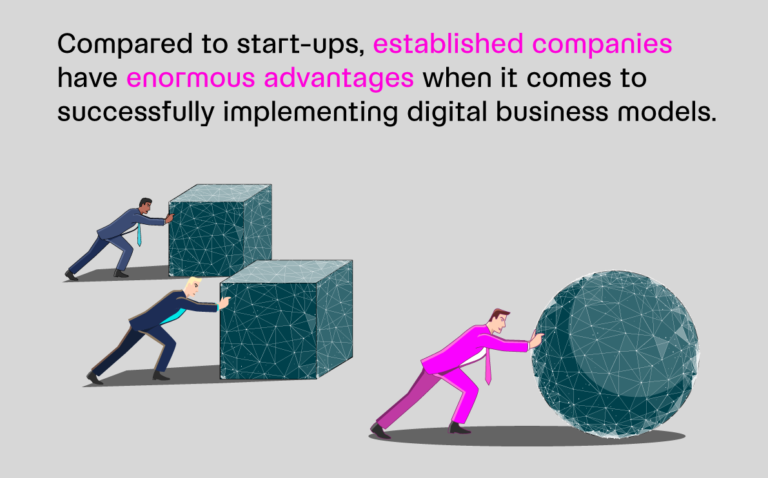Digital transformation is creating platforms that are becoming increasingly important for the functioning of the economy. Through digital platforms, companies can tap into new target groups or entire markets, develop innovative products and automate contact with suppliers and customers.
Digital platforms have a disruptive potential. If they are successful, this affects the whole market. This means that even small and medium-sized enterprises cannot avoid dealing with digital platforms. In the small and medium-sized enterprises in industry-related sectors, almost 70% already use digital platforms. The majority use them for B2B sales (49%) and purchasing (47%).
The importance of digital platforms will increase in the future. In this article, we explain why this is so, what the great potential of digital platforms is, what this means for the digital transformation and what opportunities and risks this offers for SMEs.
The triumph of digital platforms
A digital platform connects two groups for the exchange of information and services – for example, customers with suppliers, suppliers with service providers. The communication works according to certain rules that are defined by the platform operator. A digital platform is essentially a triangular relationship between platform operator, supplier and customer.
Digital platforms are so-called “two-sided markets”. A two-sided market is neither limited to the business sector nor is it necessarily digital. Even a dating app or a flea market are digital platforms.
But it is only in the context of Industry 4.0 that the two-way markets in the form of digital platforms are becoming increasingly important. Industry 4.0 changes the requirements for modern production. On the one hand, it must be quickly upwardly scalable, on the other hand, it must offer a high degree of individualisation of the products.
This is exemplified by the German automotive industry. The networked car has long been a reality. Even today, an average car processes up to 25 gigabytes of data per driving hour. But cars do not only produce data, they will also process them in the future. The car will thus increasingly become an integral part of the user’s digital world. The automotive industry is working to create a seamless user experience by using this data to offer customers appropriate products and services.
This is how digital platforms earn their money
Every digital platform consists of a core and the periphery. The core forms the heart of a digital platform. The periphery is built on this core. Peripherals are products or services that have been developed on the basis of the platform for end customers.
The operator of a platform has basically two possibilities to earn money with his platform. Either via the periphery or via the end consumer.
A common business model is to subsidise one source by another. For example, the major game console manufacturers have already brought their consoles to the market below production costs, because this way they bind the end customer to their own ecosystem in the long term. In turn, developers pay a licence fee to the console manufacturer. The more customers they can attract to their platform, the more interesting it becomes for the developers to produce for the platform.
The basis in any business model is a functioning ecosystem.
In theory, the platform operator can determine the rules of the platform, but in practice such platforms take the form of a self-regulating system. Only if the platform remains attractive for end customers and developers will they not migrate to the competition.
What happens if an operator changes their business model and thereby misjudges the ecosystem can be studied, for example, on the Kleiderkreisel platform. Originally, Kleiderkreisel was founded as a purely digital marketplace that provides the technical infrastructure for users to sell clothes to each other. This concept was successful, and a healthy ecosystem was created. However, the platform was not profitable. Therefore, the operators interposed their own payment system, so that the platform is between all transactions of the users. The basic rules of the platform were fundamentally changed. The users reacted very negatively in the short term and within a very short time, many competing platforms sprang up. In the long term, Kleiderkreisel was able to stabilise its own ecosystem, but this example shows how important and at the same time how fragile the ecosystem of a digital platform can be.
Why digital platforms are becoming increasingly important for the economy
Digital platforms are fundamentally changing the economy. The classic one-sided markets are increasingly being replaced by two-sided markets. Business models are dependent on functioning ecosystems. This is the only way to create the effects that make digital platforms important and attractive.
Rapid growth and network effects
An important factor for the spread of platforms lies in the platforms themselves. Because platforms systematically depend on a large number of users to function as a platform, they must grow as quickly as possible, especially in the early stages. A functioning business model that generates profits plays a subordinate role. Large platforms like Facebook were not profitable for years – and yet they were regularly valued at high amounts.
Rapid growth is important for digital platforms because it is the only way to create network effects. Network effects are one of the important reasons for the disruptive potential of digital platforms.
Network effects are easily explained: the more users a platform has, the greater the benefit for all participants. Social networks, for example, become more interesting for individuals the more people they can potentially meet on the platform.
Scalable and customisable production
Since there has been talk of Industry 4.0, there has also been talk of lot size 1 as the goal of the digital transformation. Lot size 1 stands for the industrial production of completely individualised products and services. The goal is mass production, which nevertheless produces custom-made products for each customer.
This is made possible by techniques such as automation, 3D printing, IoT – and digital platforms. After all, lot size 1 can only be achieved if individualisation can be combined with high production scalability. Since digital platforms are modular in themselves, they form a good basis.
This can be seen for example in the transformation of the well-known ERP systems. Whereas these used to be operated directly by the company on its own server, today companies rent the software from the manufacturer, who runs it on their own server farms. As a result, the system can be scaled almost arbitrarily if required. Thanks to a functioning ecosystem with third-party developers, the company also has extensive customisation options to adapt the system to its needs.
Incentives for innovation
Innovation management is also being modernised through digital platforms. The separation of core and periphery makes the core reusable, and the periphery can be procured as required. This reduces costs and innovations can be realised faster.
Reduction of transaction costs
Digital platforms reduce transaction costs. All costs associated with the purchase and sale of goods and services are reduced if a two-way platform is used instead of the classic one-way markets.
This can be seen in the music industry, for example. Whereas musicians used to have to find a label that would pre-finance the production of their CD and then distribute it, today they simply upload their music onto one of the relevant platforms and make it directly accessible to a huge target group. Ultimately, the labels also benefit from these platforms, as transaction costs are also reduced for them.
Open, semi-open and closed platforms
Not every platform works in the same way. They differ in terms of access restrictions and applicable rules within the ecosystem. A schematic distinction can be made between open, semi-open and closed platforms.
Open platforms: An example of an open platform is the Linux operating system. The source code of the Linux kernel is available free of charge and accessible to everyone at any time and can be modified as desired.
Semi-open platforms: An example of a semi-open platform is a developer API, for example for Amazon Web Services (AWS). Through an API, a software manufacturer provides external developers with access to functions of the programme. However, access is restricted by the limitations of the API. APIs also illustrate the smooth transitions between open, semi-open and closed platforms. Different APIs offer developers different levels of freedom.
Closed platforms: A closed platform for example is the Microsoft Windows operating system. Microsoft develops the Windows platform and makes it available. Developers can program software for the platform, but they must follow the rules of the operating system. Unlike Linux-based operating systems, the source code of Windows is secret and may not be changed.
Closed, open and semi-open platforms can all be successful in the market. Each platform operator has to balance between control and dissemination. An open platform usually spreads faster, but as an operator you have no control over the development of the platform. This in turn can have positive or negative effects.
Facebook was originally only a small platform for the students of a single university. The reason why the platform has become so widespread is that, in principle, no access barrier was built in. So Facebook quickly spread to other universities and eventually to the whole world.
An example of a negative impact of an open platform is the first game consoles in the 1980s. In the wake of the first major gaming hype, the major console manufacturers such as Atari wanted to bring more and more games to the market. To achieve this, practically anyone could program and publish games for the console. There was de facto no quality control. This ultimately led to the collapse of the company.
Conversely, a closed platform can mean that the hurdles are too high and the critical mass of necessary users is never reached.
There is thus a U-shaped relationship between control and dissemination. Platforms that are too closed do not build up a significant number of users and thus no functioning ecosystem; platforms that are too open are sluggish and usually not innovative.
How SMEs should use digital platforms
Digital platforms are fundamentally changing the markets and this development is far from complete. With their triumphant advance, not only the conditions on the markets are changing, but also the demands of customers. Due to their good scalability, large network effects and lower transaction costs, digital platforms are the future in many industries and areas.
In principle, however, SMEs should be careful when setting up their own platforms. The development of a technical platform with its own ecosystem in particular is associated with high costs, without the expectation of medium-term profits. Large corporations have an advantage here. Small and medium-sized enterprises have the advantage of being able to react faster and more agile than large companies. They should make use of this advantage and concentrate on those areas where there is direct contact with customers and business partners.
In these areas, the use or establishment of digital platforms also makes sense for small and medium-sized enterprises:
- Automation of B2B sales via external platforms (e.g. LinkedIn)
- Development of own trading platform/use of existing platforms (e.g. Amazon)
- Use of platforms for data evaluation
- Use of platforms to create decentralised value-added networks (e.g. leasing of released production capacities)




